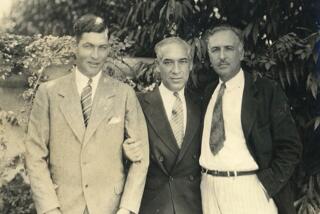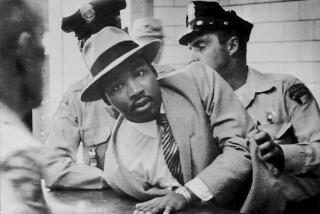Book review: ‘The Pale King’ by David Foster Wallace
- Share via
“The Pale King” is composed of parts of the “something long” on which 46-year-old David Foster Wallace was working before he hanged himself at his home in Claremont on Sept. 12, 2008.
Wallace — author of fictions such as “The Broom of the System,” “Girl With Curious Hair,” “Infinite Jest” and “Brief Interviews With Hideous Men,” not to mention a score or so of wonderful loopy discursive nonfiction essays on subjects as diverse as tennis, John McCain, David Lynch, cruise ships, and baton-twirling — left more than 200 pages of typed manuscript for “The Pale King” in a neat pile, almost as if spotlighted, on the desk in the garage that served as an office. Thousands of other pages and fragments were later found elsewhere in the garage, on hard drives and floppies, in storage boxes, file folders, three-ring binders, and notebooks adorned with smiley stickers.
It’s hard to define exactly what “The Pale King” is, let alone judge it — are we talking about an unfinished novel, or just a version of an unfinished novel or a grab by publisher and estate or a fine and necessary tribute to a writer whose pain, genius, and, yes, tragic glamour, have touched so many? Reviewers line up to debate the point. The book, as here published, has been assembled by Michael Pietsch, Wallace’s longtime editor at Little, Brown. Pietsch has accomplished the task with diligence and even, I’d venture to say, love, though the 500-plus page result is inevitably just a guess at the intentions of a writer who was an obsessive reviser and a notoriously reluctant finisher of his work.
“The Pale King” opens beautifully, elegiacally, in the landscape of the Midwest, where Wallace spent his boyhood. “Electric sounds of insects at their business. Ale-colored sunshine and pale sky and whorls of cirrus so high they cast no shadow. Insects all business all the time. Quartz and chert and schist and chondrite iron scabs in granite. Very old land. Look around you. The horizon trembling, shapeless. We are all of us brothers.” The fact-filled plentitude recalls Whitman, reminding us that despite Wallace’s fondness for footnotes and authorial intrusion and mock-transcripts (devices all featured here, and in spades), the default mode of his later writing recalls John Updike’s realism as much John Barth’s meta-fictional trickery.
The bulk of “The Pale King” then swings between the lost childhoods and current daily grind of a group of characters who work at an IRS Regional Examination Center in Peoria, Ill. “Ken Wax turns a page. Chris ‘The Maestro’ Acquistipace turns a page. David Cusk turns a page. Boris Kratz turns a page. Robert Atkins turns two separate pages. Anand Singh turns a page. R. Jarvis Brown uncrosses his legs and turns a page. Latrice Theakston turns a page. The slow squeak of the cart boy’s cart at the back of the room.”
The time is 1985, selected as a decisive and ill-omened moment when the balance of the culture tilts away from civic responsibility and toward mechanized dehumanization and a corporate menace that will be aided and abetted by changes in the tax law. “Something’s happened to people,” says one un-named character, trapped in the dark in an elevator stuck between floors, during a long chapter which Wallace turns into a hectoring Socratic dialogue on the question “whither America?”
Wallace’s subjects in “The Pale King” are loneliness, depression and the ennui that is human life’s agonized bedrock, “the deeper type of pain that is always there, if only in an ambient low-level way, and most which most of us spend nearly all of our time and energy trying to distract ourselves from.”
“The Pale King” dares to plunge readers deep into this Dantean hell of “crushing boredom,” suggesting that something good may lie beyond. “Pay close attention to the most tedious thing you can find (tax returns, televised golf) and, in waves, a boredom you’ve never known will wash over you and just about kill you,” Wallace writes in a note that’s included at the end. “Ride these out, and it’s like stepping from black and white into color. Like water after days in the desert. Constant bliss in every atom.”
Is Wallace describing a literary effect he hoped to achieve or the Zen-like state to which the ultimately doomed attempt to compose “The Pale King” would sometimes exalt him? Maybe both. Wallace’s writing preaches the rewards of the hard work involved in paying close attention, and he was such a great observer of the world out there precisely because he itched to escape the prison of his own self. In his crusade against solipsism Wallace obsessively takes apart and puts under his prose microscope the intricate machinery of our flawed attempts at communication. No wonder he feared his head would one day explode.
“The Pale King” features an array of laid-back yet scintillating sentences, bucketloads of anecdotes and comic asides, a number of indelible characters to add to the Wallaceian roster, and more dull tax facts than the average CPA or even the most fanatic Wallace nerd will care to swallow. There’s plenty of great writing and swathes of dead ink too. Wallace, so discursive, nonetheless fashioned hypnotic and coherent fictional worlds, and this embryo of “The Pale King” really does work in that regard, bounding through different timbres and tones of the American language while gathering the atmosphere of lost struggling people locked together in a strange institutional community. “Infinite Jest” gave us a mega-fiction revolving around Americans’ addiction to addiction. “The Pale King” promised to be something deeper and more mournful — using the IRS as a metaphor for American sadness and loss, and American heart too.
Wallace, English novelist Zadie Smith has written, was “an actual genius” who always “chose the path of most resistance.” Much of the “The Pale King” is indeed hard work, but it’s welcome rather than the reverse, a shadow of the now lost “something long” that Wallace might or might not have completed but still brilliant, a Spruce Goose of a book that barely achieves takeoff but glimmers and sparkles with sufficient suggestions of the grandeur that might have been.
More to Read
Sign up for our Book Club newsletter
Get the latest news, events and more from the Los Angeles Times Book Club, and help us get L.A. reading and talking.
You may occasionally receive promotional content from the Los Angeles Times.






